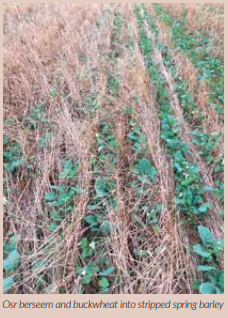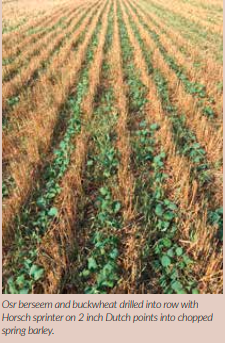“Driver Farms is a family run 1200ha contract farming business based in Suffolk farming hanslope series clay. They practice a regenerative agriculture system based on zero and min till. All agronomy is carried out in house. They are also five years into running a 12m CTF system’

I have just been to look at a field of our no till rape. Not much rape on this one. Flea beetle is probably the automatic thought for many when OSR fails, it’s a great way to divert any blame from your own management. Roared through with a tillage train and got rid of any modicum of moisture? Flea beetle. No tilled into a stripper headered field of spring barley that you know needs mole draining and has a history of bad slugs? Flea beetle did it mate, not my fault they took our chemicals away.
It is my fault. Probably shouldn’t have planted it in first place and moled as planned, probably should have been more vigilant on slugs, probably drilled it too deep. At least we have learnt something and can now improve for next year. Happily, the rest of the OSR looks good with its companion crops of buckwheat and berseem clover into both stripper headered and chopped spring barley, disc and tine drilled respectively. We have not used any insecticides, but this was never really on the cards anyway as it seems resistance to pyrethroids has built hugely and the impact on beneficial’s is too much. However, they haven’t really been much of an issue.

We aren’t in a flea beetle hotspot but have done everything in our power to try and combat them. Very high/stripped stubble, early drilling, no till, companion crops, a farm system now based around trying to build ecosystems. So far so good, but let’s wait and see what it’s like in the spring. The bad field will be moled this week (1st Sept), follow by a dose of chicken muck, followed by a shallow cultivation in which we will broadcast a cover crop.
Last October we planted wheat into stripper header harvested spring oats. We used a couple of different demo drills which were both great (Sly Boss, Horsch Avatar). It looked a wonderful mess for a long time, neighbours seemed to be looking at it a lot. I loved the thatch of soil armour it provided and the wildlife seemed to thrive. It ended up yielding very similar to the standard shallow cultivation we would usually do, there was also less blackgrass (but still too much) on what is a bad block. The headlands were worse however, but again this was my fault. Usually I drill headlands last, however I should have done them first and avoided running straw down in all directions. Lesson learnt and I did the headland first to good results when drilling the OSR into similar conditions. On the back of the original demos we bought the Horsch Avatar, sharing it with another similar sized farm. It complements our tine coulter Horsch Sprinter fantastically. The Sly is excellent and I thoroughly recommend it, but it wasn’t being made in the 12m wide version we wanted to fit in with our CTF system.

We have planted a lot of cover crops this year, broadcast from the back of a cultivator. We have seen big yield differences between pure no till and shallow cultivated land in spring crops. Most of our land is owned by other people so we cannot afford the risk of no till in the spring yet. This seems like a good compromise for the time being as the system evolves, we learn more and the soils improve. It’s all very well trying to no till some of this clay in the spring, but not if it could cause us to lose business. Although our aforementioned co-owner of the avatar drill claimed he could see “Plumes of carbon” rising from our cultivator from 3 miles away…
Cover crops comprise of phacelia, buckwheat, linseed, sunflower and some clover. I saw someone talking about this sort of mix on social media or a magazine and copied it. Cost is about £24/ha and the components have all been used in various other mixes in the past, they are the ones that were always the most useful. The aim is to balance C:N ratios and not have too much residue to deal with come spring. I am loathed to use any brassica in a cover crop, they seem to breed slugs horrendously, mustard especially seems to cause more problems on our clay soils. I also heard an interesting theory that involved beneficial nematodes that are predatory to slugs. What do spud farmers use for PCN? Biofumigant brassicas, work that one out.

This whole web of nature that we are trying to work with becomes ever more complicated to me by the day. Modern agriculture is essentially based around putting the correct active ingredient on to kill a pest, weed or disease at the perfect timing and making sure you put fertiliser on in some nice even splits, again at the correct time. There is an idea of ‘integrated farm management’ that is regularly read about these days, but to me this is still based around chemical answers and mainly involves threshold, not chucking chemical on just in case and trying to stop chemicals getting banned. Which is good stuff but just a start.
Regenerative agriculture is an exciting next step where the farm system is no longer built around synthetic chemicals and fertiliser, instead they are a useful and important addition within the system. In place we are building our own defences by trying to harness nature and all its power (which as we know always beats chemical answers eventually anyway). There are to be an exciting evolution happening amongst farmers who have started to really change the way that profitable high yielding farming can be done. I am not one of these yet, but I am happily copying and learning as much as I can from these guys if I think they will work on our farm. Twitter is a great tool for this kind of lurking and learning, especially if you can avoid arguing and debating. I struggle with that though!
There is a lot of doom and gloom in farming at the moment. You open a magazine and another industry leader is writing about how unfair it is another chemical has been banned or how the consumers don’t value us. It’s both negative and defensive but an understandable reaction in difficult times. What I have found since getting into this regenerative ag thing about 5 years ago was how positive everyone involved is about the farming and the future. The atmosphere at Groundswell was a myriad of thought. The lectures so full of information and methods that you simply do not hear about at more conventional events like Cereals. The trend seems to be growing, the more of us starting to tread this path the more we will learn. This farmer to farmer knowledge exchange is key for us going forward.

What’s next? We often hear the phrase that fixed costs are variable and variable costs are fixed. Our fixed costs are in a good place according to benchmarking we do. I do believe there is still room for improvement, but in reality this kind of cost saving is fairly black and white, it’s instantly obvious where costs can and should be saved. This is basic business and should be addressed quickly if there are issues. With this sorted, and a smooth office system running it leaves us time for the most important thing we do, growing our crops and developing the system.
The variable input costs are much harder to start cost cutting on. It is such a fine line between a certain product producing a positive margin over input cost and these details are often difficult to quantify on a farm scale. Again, looking at benchmarking we are low input compared to many. My father and I do our own agronomy here so the buck falls with us which gives us the confidence to cut back when needed. This isn’t without excellent information we get from NIAB and CMI. However, this is just cost saving in a conventional agronomy system and this can be done through buying well and knowing what you are doing agronomically. What I am trying to learn more about is how we start using biology and nutrition to help with crop protection.
I believe we are just scratching the surface of this. The added benefit is moving towards this kind of system will also help massively with aforementioned ‘IFM’ taking the pressure off the active ingredients and allowing them to be used less but more effectively. I have been running around with a brix refractometer and taking tissue leaf samples, but I will be honest and say I am only just starting to get a vague understanding of this and how it can affect our fungicide programs or issues with insects. Brewing up beneficial biology is an exciting prospect for next year and I have a tank set up ready to do it. I have learnt about this sort of thing by visiting BASE UK members farms with a group called Agricecology.
Despite the uncertainty surround our industry, I believe exciting times are ahead. A sharp and open mind with a working calculator will be important tools going forward and as always, a willingness to take some risks.